Shot Scope Connex Tracking Tags - Review
Posted by Jamie Martin on 17th Oct 2023
I don’t know about you but whenever I think about shot trackers, they usually don’t have a price tag of $170.
In fact, I normally visualise someone who looks like the Monopoly Man, a.k.a. Milburn Pennybags, quaffing cognac with his top hat on while poring over his shot tracking statistics.
However, Shot Scope have come up with an ingenious idea to give slightly poorer golfers the opportunity to track their golfing data.
The new Shot Scope Connex shot tracking system is a cheap, entry-level option targeted at golfers who are considering jumping into the analytical golfing waters.
For around $170, with no ongoing subscription fee, you get 16 Connex tracking tags, along with a fully functional GPS distance device via the Shot Scope app.
But what’s the catch?
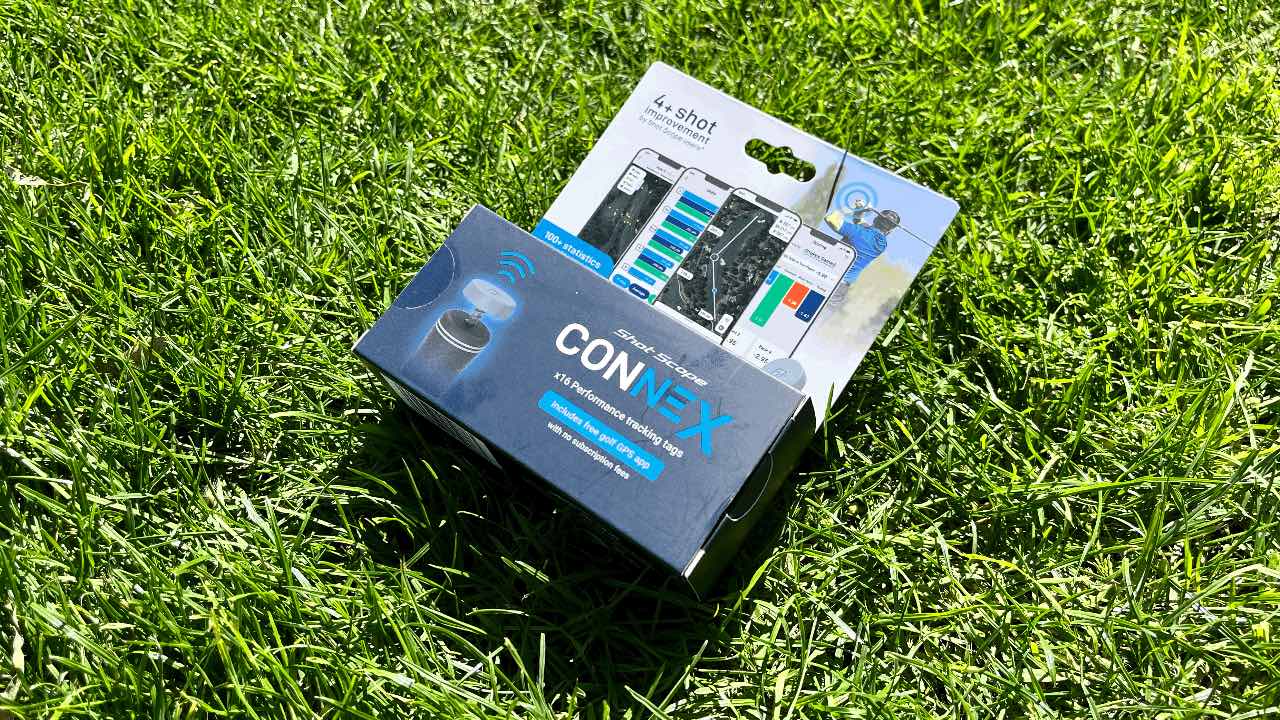
WHY’S IT SO CHEAP?
Shot Scope Connex isn’t as sophisticated as other analytics devices on the market, but that doesn’t necessarily mean it’s not as accurate or effective.
First of all, Connex is not automatic; the tracking tag of your selected club needs to be held near your smartphone (which should preferably be located in your front pocket) to register a shot.
It’s a very similar routine to that of first-gen shot trackers, which begs the obvious question: why would Shot Scope introduce a product that seemingly features retrospective technology? Especially since their G5/X5 watches do offer automatic shot tracking?
The best answer I can come up with is a comparison with the affordable iPhone SE model.
The SE doesn’t have the latest, or best, technology but it’s a cheap way to enter the Apple ecosystem.
In much the same way, Connex represents an inexpensive avenue into the shot tracking space.
CONNEX SET-UP
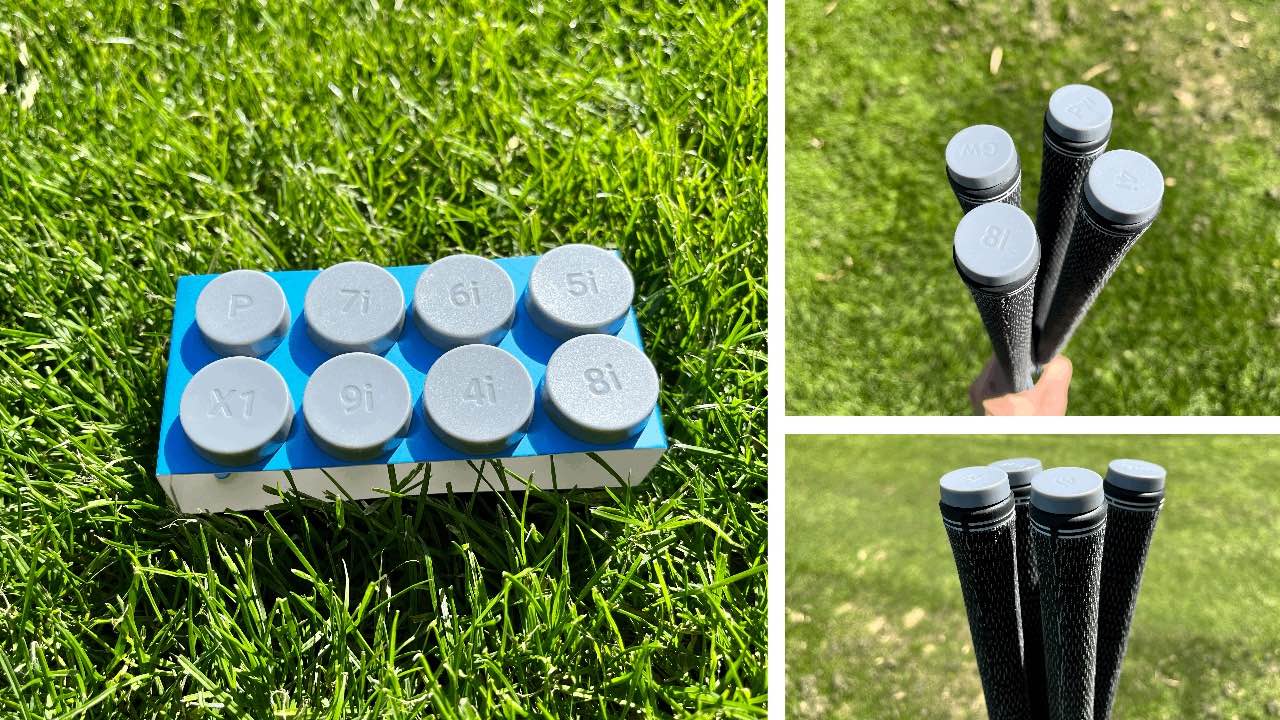
The 16 tags that form the basis of Shot Scope’s Connex are just like other tracking tags.
They screw into the grip of the club they correspond with (they’re all labelled with initials) and weigh just 2g (you’d have to have OCD to notice them).
They look like close relations to Shot Scope’s X5 tracking tags but are grey, rather than black. And no, they aren’t interchangeable.
While the legal limit is a maximum of 14 clubs per bag, Connex supplies a couple of extra tags for golfers who frequently swap clubs in and out of their bag.
With the tags fitted, the next step involved recording the brand and model of every club in the MyBag section of the Shot Scope app.
Unfortunately, this step proved to be as pointlessly infuriatingly as a Married At First Sight reunion.
Rather than typing in a brand name to find a match, the maddening app directed me to scroll through an alphabetical list containing almost every brand in the history of the game until I found what I was looking for.
Surely a sub list of the most popular brands at the top would’ve offered a far more frictionless experience?
The Shot Scope app did have a time-saving feature that copied over the details of your previous club, which made entering an entire set of irons much quicker.
Despite the frustration of having to scroll through a list that was longer than a director’s cut of Oppenheimer, there was a silver lining.
I happened to chance upon an intriguing brand called Golf Southern Style, which kind of sounded like golf clubs that might’ve been coated with the Colonel’s secret blend of herbs and spices.
FIRST IMPRESSIONS
Opening the Shot Scope app presented the usual “pick your course, pick your tee” options before a full screen satellite image of the first hole appeared.
After mostly using GPS watches, viewing an aerial image — rather than a graphical representation — did feel like a refreshing change visually.
All the regular favourites, such as front, middle and back distances to the green and drag-and-drop yardages to anywhere on the map, were available and it seemed like a perfectly clever and well executed GPS app.
But for me, the burning question was: did that functionality extend to the tracking tags?
To activate shot tracking, I tapped the WiFi thumbnail on the map screen to engage my phone’s NFC scanner (that thing that lets you make card payments with your phone).
I edged the tracking tag towards my phone’s camera (the location of the NFC scanner is different depending on the smartphone) until I felt the phone vibrate, which was the green light to go ahead and hit the ball.
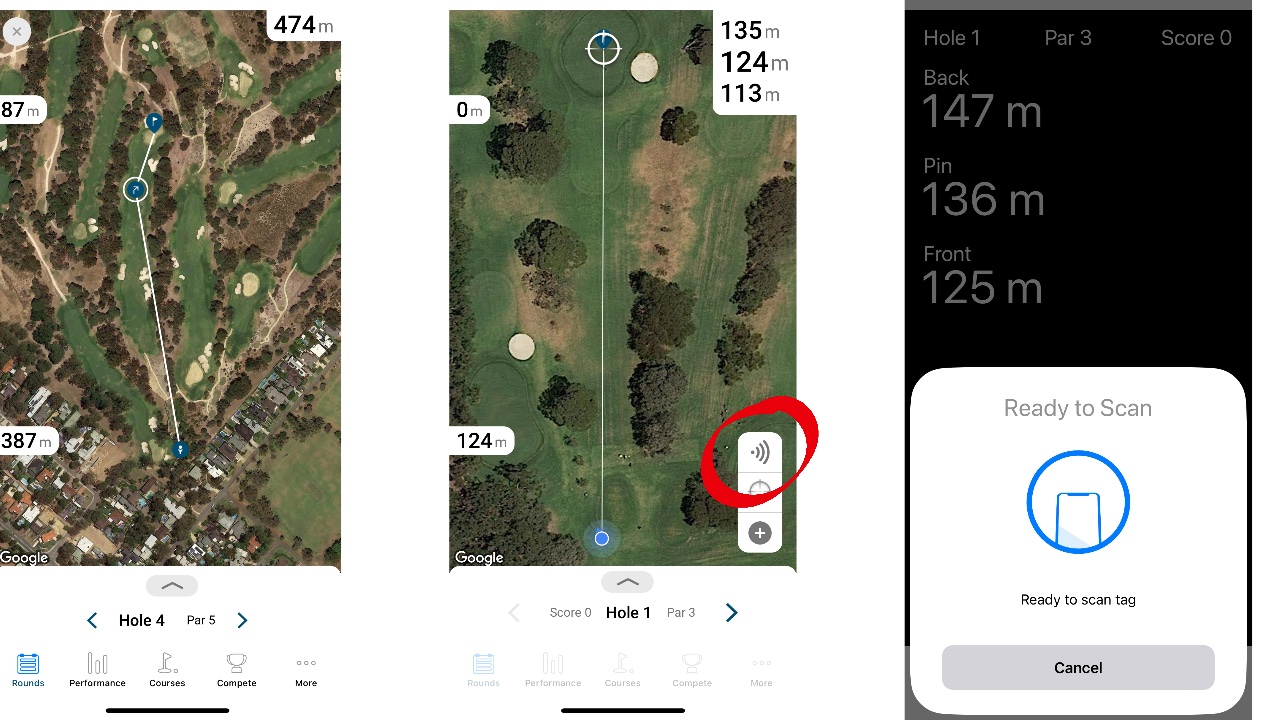
HOW IT PERFORMED
I don’t know about you, but strange things seem to happen when I leave an unlocked phone in my pocket.
There was a string of random FaceTime pocket-dials to the boss that I only discovered weeks later in my Recents log.
Then there was a minutes long voice message to a Whatsapp group chat that consisted mostly of the “shhhh, shhhhh, shhhh” noises that a phone in a pocket generally makes, interspersed with the muffled voices of an incomprehensible conversation (my wife pointed out it didn’t sound too dissimilar to most of my verbal interactions with her ever since we had kids).
It's safe to say I’m a little gun-shy about leaving my phone unlocked and my considerable caution highlighted in my mind a glaring issue with the Connex shot tracker.
You see, the Shot Scope user manual recommends leaving your phone unlocked (in your phone settings you can turn off the screen lock) in your front pocket.
If you don't, you need to unlock your phone, tap the scan button then tap the tag before every shot, which felt like a pre-shot routine before getting to your pre-shot routine.
In my mind, an unlocked phone in the pocket did seem like inviting chaos into your life, however, in the interest of providing a thorough review I threw caution to the wind and went fully unlocked.
Despite my fears, things turned out OK and I could understand why leaving your phone unlocked phone made sense, just because the tagging process was much quicker and smoother.
However, I did experience another issue: there were a few holes that had inexplicably linked up, which I later determined had something to do with me maybe pressing the Pin Collect button (more on that in a sec). Or was it not pressing the Pin Collect button? I couldn’t tell.
Anyway, it was easily corrected via some post-round editing (which is also available should you forget to tag on for a shot) but it was still a bit of a headscratcher.
On the greens you still need to tag on with your putter. But when you’ve holed out, Connex’s Pin Collect function will do the rest (for the most accuracy, make sure you tap the Pin Collect button while standing at the hole).
However, you can always add in putts later, which I thought may be a better use of time when trying to clear the green or making way for your playing partners to putt out.
CONNEX STATISTICS
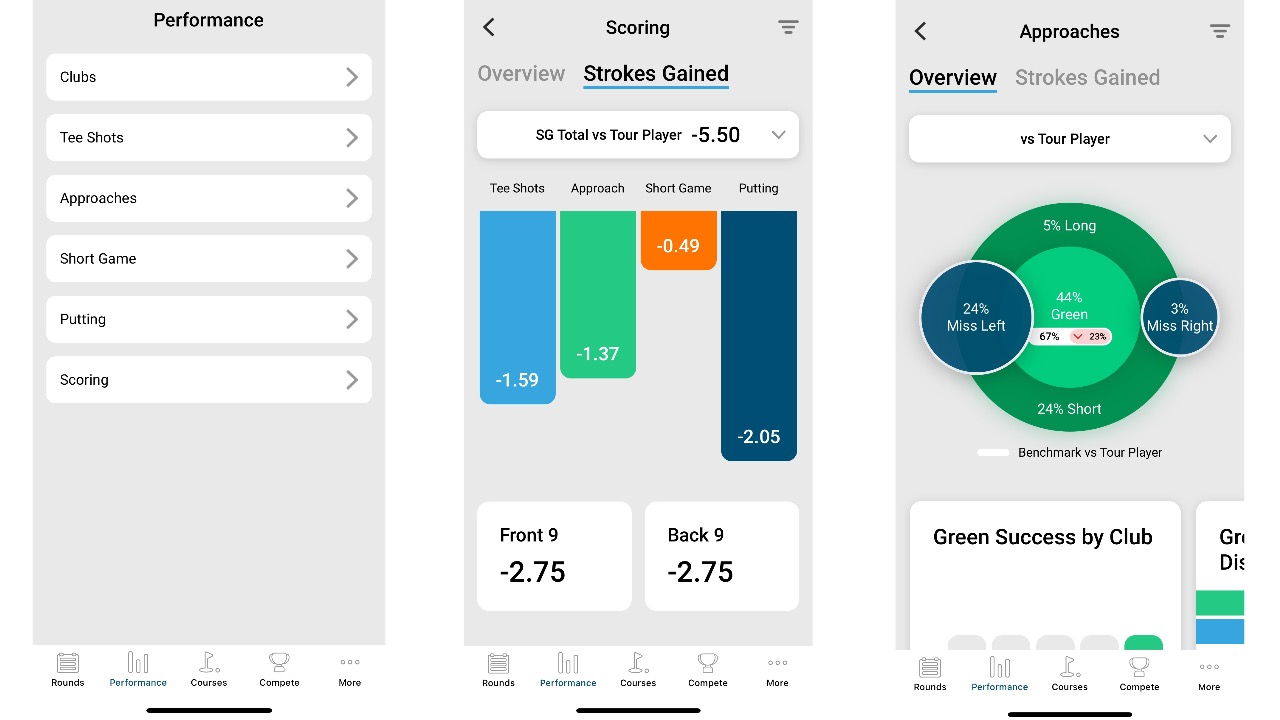 At the end of a round there’s a massive wealth of statistical information that I have little doubt will tell you everything you want to know about your game.
At the end of a round there’s a massive wealth of statistical information that I have little doubt will tell you everything you want to know about your game.
Over 100 stats are tracked by Connex, with data segmented into six different areas: clubs, tee shots, approaches, short game, putting and scoring.
While the amount of information can be a little hard to digest at first, the more rounds you get under your belt the more sense it should make.
There’s a broad overview of your game in each category, which identifies your strengths and weaknesses, but you can also drill down into each club to see how it is performing in distance, accuracy and effectiveness in all manner of scenarios.
However, I think the best feature is Shot Scope’s Strokes Gained measurement.
It allows you to see where you’re going OK and where your game is breaking down compared to players at a similar handicap/talent level.
And if you’re keen to improve, you can compare your strokes gained stats against other handicap levels (even Tour pros) to see which areas they are smoking you in.
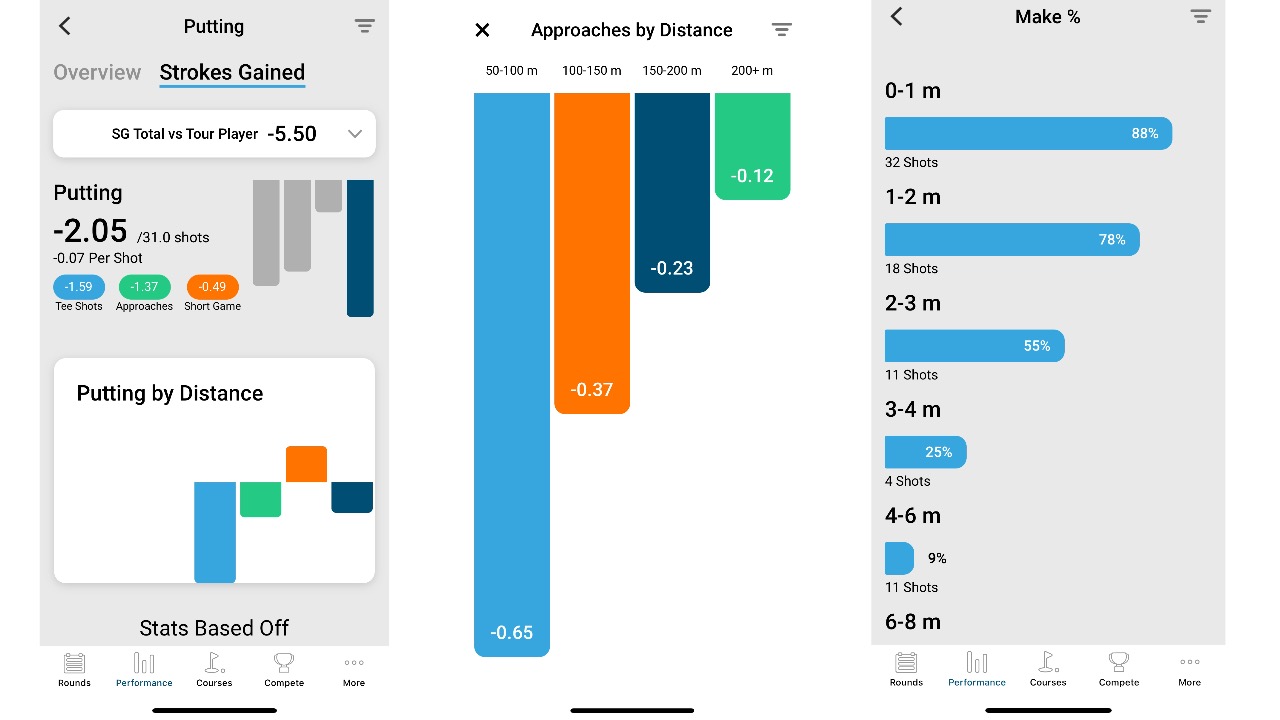
THE FINAL WORD
Now clearly, Connex is at the tightarse end of cheap when it comes to shot trackers and it’s not hard to notice why.
Shot Scope have kept costs down by opting for a manual tagging procedure, which will probably put some off given there are automatic shot trackers available (Shot Scope’s G5 or X5 are just some of them).
But that’s missing the point of Connex.
With its entry level price point, it’s basically a free hit to get into the data analytics space.
While its functionality might be at the basic end of the spectrum, the pipeline of data is as good as anything included with a premium shot tracker.
Shot Scope estimates the average golfer can shave four strokes a round by using Connex (it says so on the box) and if that is the case, for AUD$170 it’s probably the cheapest way to shoot lower scores.
Aside from the manual tagging, the fact you need to have your phone on you while playing might be off-putting for some.
You could still use Connex with your phone in a holder on your bag but to retain accuracy you’ll have to drive you bag to exactly where your ball is, tag on, then park your bag somewhere else (you obviously can’t do that on the greens, so you’d have to manually log your putts afterward the round.)
However, all of that shouldn’t be a dealbreaker.
In fact, if you were only using the included Shot Scope GPS app Connex still represents excellent value.
For the price, Connex is worth a risk.
And for what $170 will buy you these days, it’s a risk well worth taking.
THE VERDICT
HIGH FIVES
• Cheapest shot tracker on the market and no subscription fee required
• Included Shot Scope GPS app was excellent
• Volume of data was as comprehensive as a premium shot tracker
• Strokes Gained statistic was an excellent addition
BUMMERS
• Manual tagging added another routine into a pre-shot routine
• Had to play with phone in front pocket won’t suit everyone
• Having to leave the phone unlocked was asking for trouble

|
Written by Jamie Martin Jamie Martin is currently locked in a battle to keep his handicap hovering around the mid-single digits. Despite his obvious short-game shortcomings, Jamie enjoys playing and writing about every aspect of golf and is often seen making practice swings in a mirror. |

